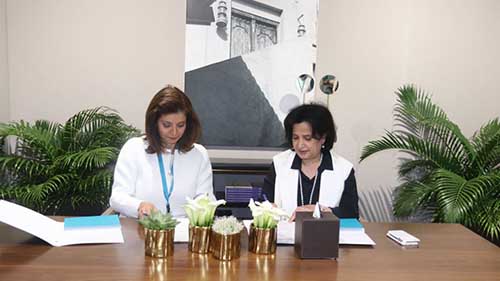26 June 2018
On the Sidelines of the 42nd meeting of the World Heritage Committee, Memorandum of understanding between ARC_WH and the National Association for the Conservation of Petra, Jordan.


H.E Shaikha Mai Bint Mohammad Al Khalifa, President of Bahrain’s Authority for Culture & Antiquities, representing the Arab Regional Centre for World Heritage (ARC-WH) as its Board of Directors ‘Chairperson, signed a memorandum of Understanding with H.R.H Princess Dana Firas, President of the National Association for the Conservation of Petra, Jordan.
H.R.H Princess Dana Firas expressed sincere appreciation and gratitude to H.E Shaikha Mai Bint Mohammad Al Khalifa and to the Arab Regional Centre for World Heritage for its crucial role in enhancing the heritage protection mechanisms in the Arab world and the safeguard of memorable vestiges. H.R.H also expressed pride and satisfaction after signing this memo which will open new wider opportunities and glamorous horizons of common cooperation, pointing out that this the first memo to be signed between the Arab Regional Centre for World Heritage and civil society sector association. This will certainly have fruitful outcomes for both parties, H.R.H added.
H.E Shaikha Mai Bint Mohammad Al Khalifa, for her part, highlighted the importance of encouraging and supporting civil society associations working on the protection of world heritage, adding that the (ARC-WH’s main mission is to develop Arab experts ‘capabilities with regard to heritage safeguard. H.E added that this memorandum heralds a new bright dawn of cooperation with civil society institutions concerned with the protection of universal world heritage in the Arab world.
Dr. Shadia Touqan, Director of the Arab Regional Centre for World Heritage, praised the extraordinary work done by the Jordanian association to protect Petra site and to safeguard the tangible and intangible prominent heritage features in Petra historical site. Dr. Shadia Touqan said that signing a memorandum of understanding between the ARC_WH and the National Association for the Conservation of Petra, Jordan is an honour and a recognition of the its crucial role as center for heritage-related societies working in the Arab world.
The memo will open the door for active cooperation between the two sides in education, raising and spreading awareness about the importance of cultural heritage in local communities, especially with regard to UNESCO World Heritage List sites. The expected impact of this memo programme is a vibrant collaboration between governmental and non-governmental institutions and communities in both countries to ensure that the latter can sustainably recreate and transmit their ICH to the next generation, while respecting the principles of the Convention. It will strengthen the place of intangible cultural heritage in sustainable development ranging from security, social cohesion and the search for relevant and quality education to food security, environmental concerns and health matters. Its long-term legacy will be institutions and particularly communities that have the capacity to safeguard and enjoy intangible cultural heritage effectively, thereby promoting mutual respect and appreciation, bringing human beings closer together and ensuring exchange and understanding among them.
The agreement also stipulates that the National Association for the Conservation of Petra, Jordan will help the ARC-WH to organize and facilitate awareness- raising campaigns via social media networks about cultural heritage, contribute to the successful organization of a youth forum on heritage protection supervised by experts and heritage specialists, in cooperation with World Heritage Committee Advisory Bodies, targeting schools and university students. All activities within the strategy aim at fully mobilizing all stakeholders (government, civil society and communities) in the decision-making, administration and practical aspects of safeguarding intangible cultural heritage, with particular emphasis on articulating policies and initiatives that address the different needs, aspirations, capacities and contributions of young women and men.







